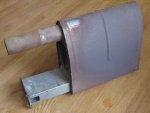Source for old service manuals
I found a copy of the owner's manual for my heater at www.bryantrv.com, specifically http://bryantrv.com/docs2/docs/operating/dt6600.pdf. It's the best source yet for guessing the age of my Skamper. The manual is dated 1979. (I couldn't locate a service manual which I assume would have a parts diagram.)
It provides orifice sizes for high altitude. 65 for 7000-9000 feet, 66 for 10,000 feet, 67 for 11,000 feet (as opposed to 61 for 0-4500 feet for which it was mfg). The manual also says "the gas input to the burner should be reduced 4% for each 1000 feet above sea level when the unit is used at elevations above 4500 feet" lest there be a build up of carbon monoxide that might make its way back into the camper. Fuel efficiency will also improve.
"Also, check gas pressure when derating the unit. First, check piping system pressure and adjust to 11" w.c. at tank regulator. Then check manifold pressure at the pressure tap location on the outlet end of the gas control on the furnace. Adjust to 10.5 w.c." Does anyone know how to do this (tools, procedure)?
Here are some other sources for camper manuals:
http://www.premiermobileservice.com/rv-owners-manuals.html
http://campingconnectionoutlet.com/w/5/rv-appliance-manuals-service
I found a copy of the owner's manual for my heater at www.bryantrv.com, specifically http://bryantrv.com/docs2/docs/operating/dt6600.pdf. It's the best source yet for guessing the age of my Skamper. The manual is dated 1979. (I couldn't locate a service manual which I assume would have a parts diagram.)
It provides orifice sizes for high altitude. 65 for 7000-9000 feet, 66 for 10,000 feet, 67 for 11,000 feet (as opposed to 61 for 0-4500 feet for which it was mfg). The manual also says "the gas input to the burner should be reduced 4% for each 1000 feet above sea level when the unit is used at elevations above 4500 feet" lest there be a build up of carbon monoxide that might make its way back into the camper. Fuel efficiency will also improve.
"Also, check gas pressure when derating the unit. First, check piping system pressure and adjust to 11" w.c. at tank regulator. Then check manifold pressure at the pressure tap location on the outlet end of the gas control on the furnace. Adjust to 10.5 w.c." Does anyone know how to do this (tools, procedure)?
Here are some other sources for camper manuals:
http://www.premiermobileservice.com/rv-owners-manuals.html
http://campingconnectionoutlet.com/w/5/rv-appliance-manuals-service
Last edited:


